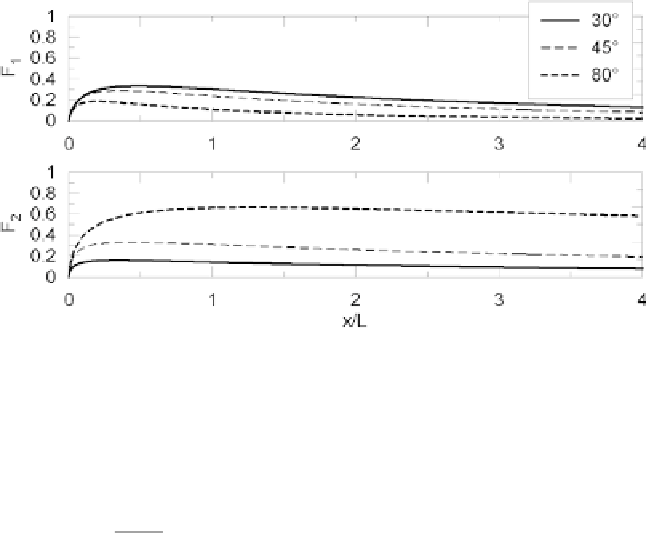Geoscience Reference
In-Depth Information
Fig. 18.5. Functions
F
1
and
F
2
ineq. (18.4) calibrated on 2D in-plane numerical
analyses. FromScandella and Paolucci (2006)
Basedonsuchparametricanalyses,anempiricalrelationshipfittingthenumericalresults
was found, which takes theform
F
1
(
,α)
1
−
η
PGV
V
s
PGS
a
=
x
/
L
,α)
+
F
2
(
x
/
H
(18.5)
1
+
η
where
V
s
is the shear wave velocity of the (homogeneous) basin,
η
is the soil-bedrock
impedance ratio
(η <
1
)
and the two functions
F
1
and
F
2
depend on the dip angle
α
,the
normalized position
x
L
of the site with respect to the basin-edge contact; the geometri-
calmeaningof
L
and
H
/
isclearfromFigure18.4.Theexactexpressionsof
F
1
and
F
2
arereportedinScandellaandPaolucci(2006),whiletheirvariationasafunctionof
the non-dimensional variable
x
=
L
tan
α
/
L
is plotted in Figure 18.5. Note that in eq. (18.5)
PGSa
and
PGV
arebothmeasuredatgroundsurfaceinthehorizontaldirection,sothattheequa-
tionshouldinprinciplebeappliedtoshallowburiedpipelines.Furthermore,eq.(18.5)is
basedonverticallyincidentplaneS-waves,whilemoregeneralincidenceanglesorwave
types are not included. However, the numerical analysis of seismic wave propagation in
almost near field conditions shown in the sequel for the Duzce case suggests that a good
approximation isalso achieved by eq. (18.5) alsoin this case.
Numerousexamplesofindependentvalidationsofeq.(18.5)basedonnumericalsimula-
tions of the seismic response of real geological cross-sections can be found in Lessloss
(2006). Here we will summarize the numerical work carried out for transient ground
strain calculations in Duzce, Turkey, that was hit by two major earthquakes on August
17 (
M
7.1), the latter one originated by a fault rupture at
about 10km distance from the town. Leaving to the following sections the details on the
damagesurveyandtheriskassessmentofthewaterpipelinesystem,weshowheresome
of the results obtained by a numerical simulation of ground motion in Duzce, involving
7.4) and Nov. 12, 1999 (
M
w
w

